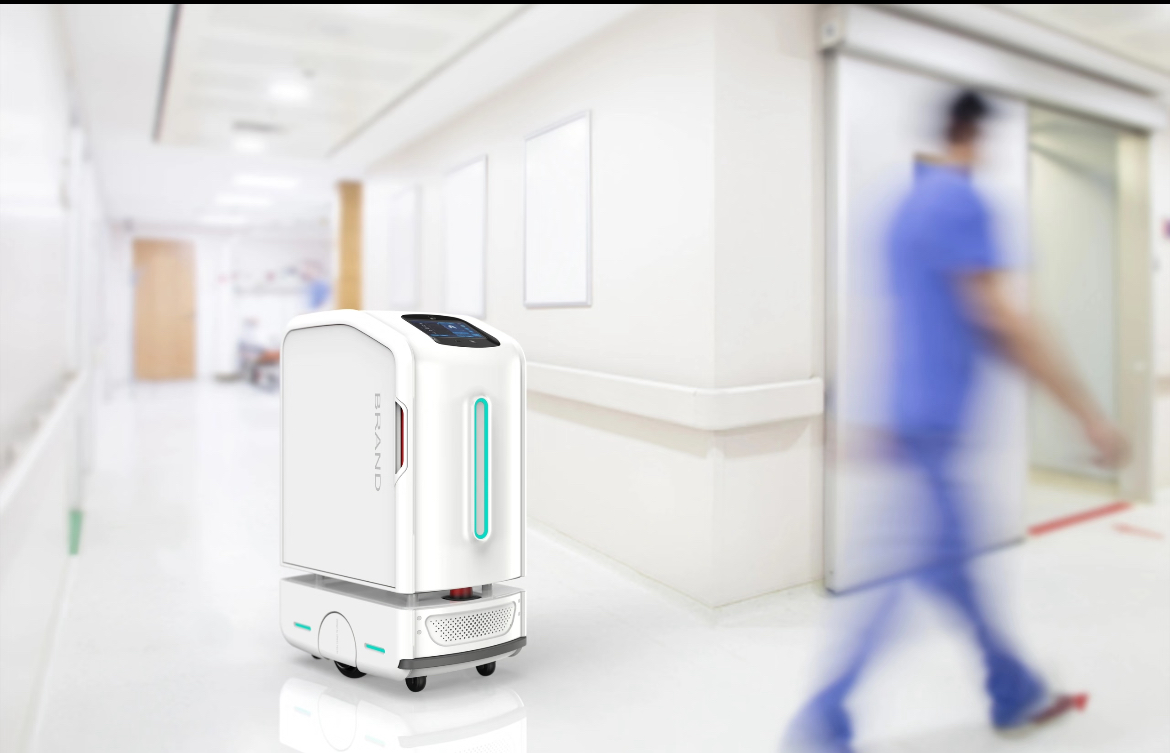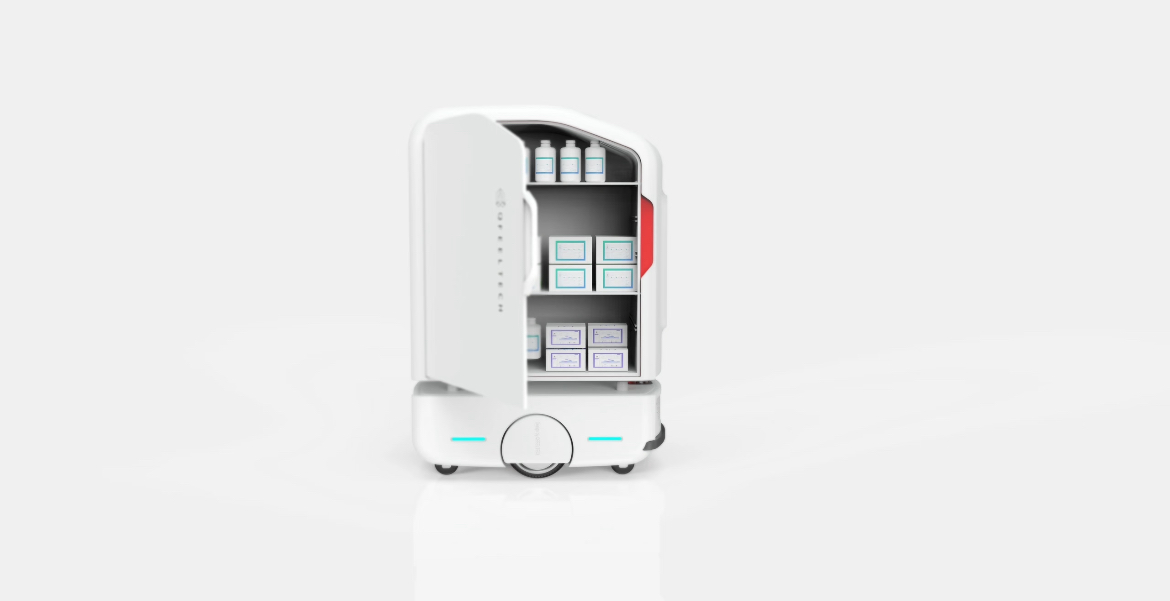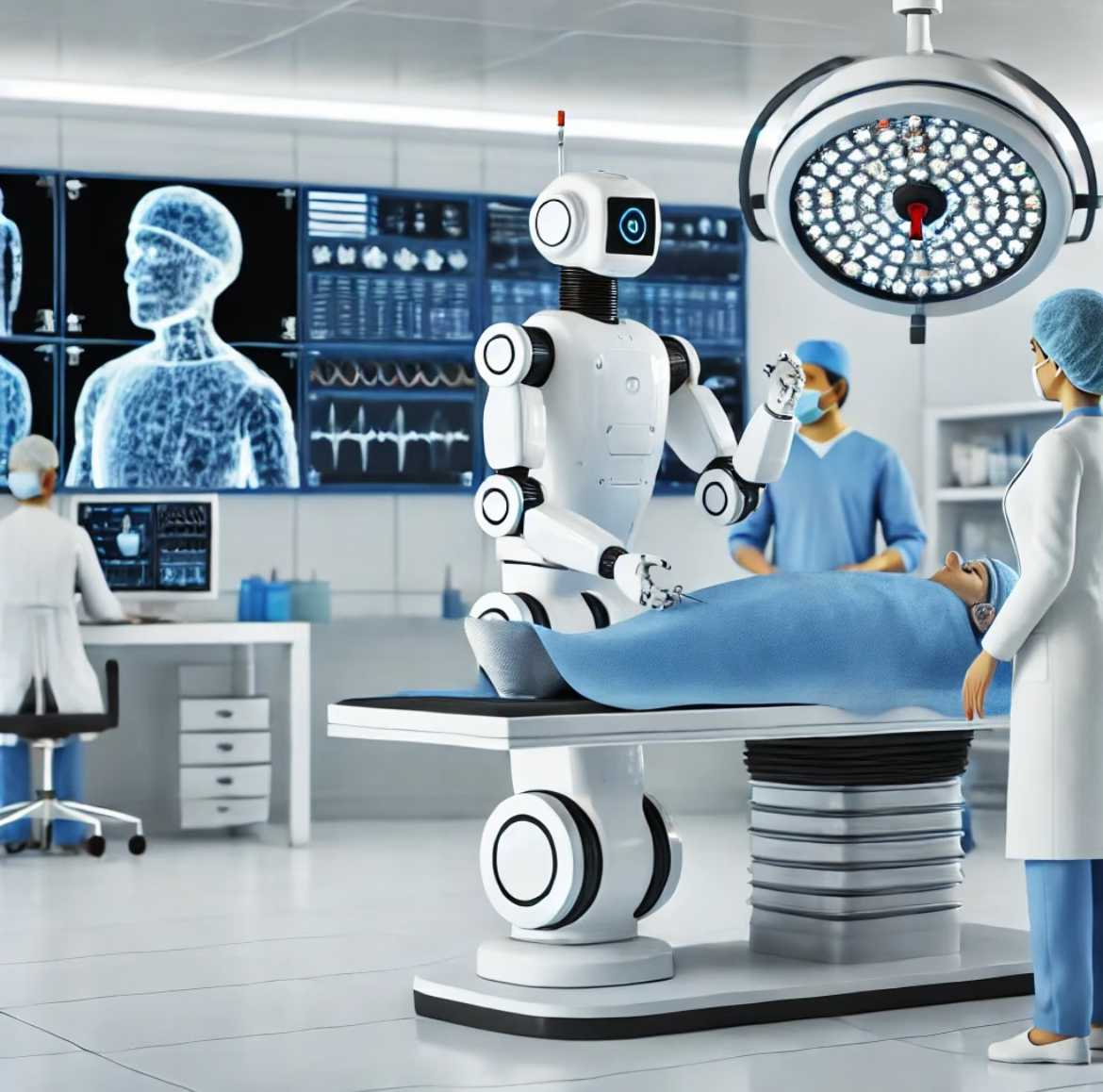Hospitals Are Rethinking Logistics in 2025
In today’s rapidly evolving healthcare landscape, the importance of efficient, safe, and reliable internal logistics cannot be overstated. Hospitals and clinics serve as critical nodes where every second counts and every delivery, be it medication, meals, or medical supplies, carries the potential to impact patient outcomes profoundly.

Delivery robot en-route to deliver supplies
Recent global events, including the COVID-19 pandemic, have pushed healthcare facilities to rethink traditional workflows and question long-standing manual processes. Human labor shortages, infection control challenges, and increasing operational costs have converged to create a pressing need for innovation in hospital logistics.

Delivery robot carrying medicines
Enter Shenpop Robotics: an advanced provider of indoor delivery robots designed specifically for clinical and hospital environments. These autonomous systems bring not only efficiency but also enhanced safety and consistency to the complex task of delivering food, medicine, and supplies within healthcare facilities.
This article explores how Shenpop’s hospital robots are redefining healthcare logistics by reducing infection risks, cutting labor costs, improving staff efficiency, and ultimately elevating patient care standards.

Find it here: popbot-h1
Why Hospitals Are Turning to Delivery Robots
Healthcare institutions face unprecedented challenges that are reshaping their operational priorities:
1.1. Staff Shortages and Overwork
Nurses and support staff in hospitals regularly endure physically and emotionally demanding shifts. The shortage of qualified healthcare professionals, exacerbated by pandemic burnout and demographic shifts, means fewer hands are available to manage critical but repetitive tasks such as internal deliveries.
Delivering medications, meals, or supplies often takes nurses away from direct patient care, adding unnecessary physical strain and inefficiencies.
1.2. Infection Control and Hygiene
Infection prevention is a top priority in clinical environments. Manual handling of food trays, medications, and medical equipment increases the risk of cross-contamination, especially in high-risk wards like ICUs and isolation rooms.
Reducing the number of person-to-person handoffs decreases potential transmission pathways for hospital-acquired infections (HAIs), a major concern worldwide.
1.3. Consistency in Internal Logistics
Healthcare facilities are complex ecosystems with many moving parts, pharmacies, kitchens, labs, wards, and administration offices all require synchronized deliveries. Traditional delivery methods are often inconsistent, prone to delays, and vulnerable to human error.
Automating delivery tasks ensures consistent timing, accuracy, and reliable communication among departments.
1.4. Managing Labor Costs Without Sacrificing Service Quality
Hospitals must balance budget constraints with high expectations for patient care. Hiring additional staff solely to manage deliveries is costly, while understaffing jeopardizes quality.
Robots provide a scalable solution that addresses these concerns by taking over routine delivery duties, freeing healthcare professionals to focus on direct patient interaction.
1.5. Shenpop’s Closed-Compartment Delivery Robots: The Healthcare Solution
Shenpop Robotics offers specialized delivery robots designed for hospitals, featuring secure closed compartments, autonomous navigation, and hygienic materials that meet medical standards. These robots reduce labor demands, minimize infection risks, and integrate seamlessly with hospital workflows.

Nurses interact with reception robot
What Hospital Robots Actually Deliver
Hospitals rely on Shenpop robots to handle a wide range of delivery tasks critical to daily operations:
|
Delivery Task |
Description |
|
Medication Runs |
Transporting medicines from the pharmacy to patient wards with secure compartments to prevent tampering or contamination. |
|
Meal Delivery |
Delivering patient meals, especially in quarantine or isolation rooms, ensuring food safety and temperature control. |
|
Supply Transport |
Moving gloves, PPE, linens, and medical kits to various departments quickly and reliably. |
|
Specimen Return |
Carrying lab specimens back to testing facilities in sealed containers, reducing contamination risks. |
|
Waste Collection |
Transporting biohazard or medical waste in sealed units for safe disposal. |
These diverse applications demonstrate the versatility of Shenpop robots in handling both critical and routine tasks within healthcare environments.
Core Features Designed for Healthcare
Shenpop’s hospital delivery robots are engineered with healthcare’s unique demands in mind. Below are the key features that make them ideal for clinics and hospitals:
3.1. Closed Compartment with Password Locking
Privacy & Security: Sensitive items such as medications, patient personal effects, or confidential lab samples require secure handling. Shenpop robots come equipped with password-protected compartments, ensuring only authorized personnel can access the contents.
Restricted Areas Compatibility: Particularly important in ICUs, maternity wards, or infectious disease units, where access control is critical.
Tamper-Proof Design: Minimizes the risk of misplaced or stolen items.
3.2. Temperature Monitoring
Food & Medication Safety: Compartment sensors maintain and monitor temperature, guaranteeing that meals stay warm and medicines remain within safe temperature ranges.
Compliance Logging: Temperature data is logged to meet healthcare regulations and ensure accountability.
Alerts & Notifications: If temperature thresholds are breached, staff are alerted immediately to prevent compromised deliveries.
3.3. Autonomous Navigation
Hospital Corridor Mapping: Robots use LIDAR, ultrasonic sensors, and internal mapping algorithms to safely navigate complex hospital layouts without human assistance.
Obstacle Avoidance: Capable of detecting patients, staff, rolling beds, and medical equipment, adapting speeds and routes in real time to avoid collisions.
Offline Operation: Designed to function even in areas with poor or no Wi-Fi connectivity by relying on internal memory and autonomous control systems.
3.4. Multilingual Voice Support
Patient & Staff Interaction: Equipped with voice assistants that communicate in multiple languages, including English, Spanish, and Arabic, and many more.
User-Friendly Interface: Nurses and other staff can interact via touchscreen panels or voice commands, making robot operation intuitive and accessible.
Customizable Language Packs: Hospitals can tailor language options based on regional demographics or specific unit needs.
3.5. Long Battery Life & Easy Charging
Extended Operation: Robots operate continuously for up to 14 hours on a single charge, covering entire shifts without interruption.
Auto-Docking Stations: Robots autonomously return to charging stations when idle, enabling 24/7 operation in high-demand environments.
Minimal Maintenance: Designed for easy battery swaps and routine cleaning, keeping operational downtime to a minimum.
Real-World Use Case – Medium-Sized Urban Hospital
4.1. Hospital Profile and Challenges
Consider a 120-bed private hospital located in Buenos Aires, Argentina, serving a diverse urban population. Like many healthcare institutions during and after the COVID-19 pandemic, this hospital experienced significant operational strain, particularly on nursing staff who were stretched thin managing patient care alongside logistical duties.
High nurse workloads, combined with an urgent need to maintain strict infection control, highlighted inefficiencies in traditional delivery methods. Manual transport of medications, meals, and supplies created bottlenecks and delayed critical tasks.
4.2. The Shenpop Deployment
In response, the hospital deployed three Shenpop delivery robots, specifically programmed for pharmacy deliveries, meal distribution, and linen transport. Each robot was assigned distinct routes covering multiple floors and critical departments such as ICUs, surgical wards, and isolation units.
The implementation process was rapid, mapping routes took less than three hours, followed by nurse training sessions focused on touchscreen interfaces and voice commands.
4.3. Results After Six Months
40% Reduction in Nurse Time on Deliveries: Nurses reported spending significantly less time on non-clinical tasks, freeing them to focus more on direct patient care.
26% Increase in Timely Medication Delivery: Automated robots ensured medication reached patients faster and more consistently, contributing to improved treatment adherence.
Estimated ROI in 8.5 Months: Cost savings from reduced overtime, fewer errors, and optimized workflows rapidly offset initial investment.
Enhanced Patient Satisfaction: Patients noted quicker meal and medication delivery, and surveys reflected improved perceptions of hospital efficiency and safety.
Safety Gains: No reported incidents of contamination or delivery errors related to robot use, underlining the effectiveness of sealed compartments and autonomous navigation.
This real-world example demonstrates how Shenpop robots help hospitals achieve operational efficiency while improving patient outcomes and staff well-being.
Infection Control - Why Robots Matter
5.1. Infection Transmission Risks in Hospitals
Healthcare-associated infections (HAIs) are a leading cause of morbidity and extended hospital stays worldwide. Pathogens such as MRSA, C. difficile, and viruses like SARS-CoV-2 thrive in environments where human-to-human contact is frequent, especially in ICUs and isolation wards.
Every additional person entering a patient’s room or handling their food and medications introduces a potential contamination vector.
5.2. How Shenpop Robots Reduce Transmission
Minimized Human Contact: Robots act as autonomous couriers, delivering sealed packages directly from point A to B without human intervention in between.
Closed, Secure Compartments: Items remain sealed inside locked compartments that only authorized users can open, preventing cross-contamination.
Easy Sanitization: Robot surfaces are made from disinfectant-tolerant materials. Wipe-clean designs and optional UV disinfection modules allow rapid sterilization between deliveries.
Consistent Hygiene Protocols: Unlike human staff, robots don’t forget or deviate from hygiene procedures, ensuring every delivery adheres to hospital infection control standards.
5.3. Especially Critical in High-Risk Areas
ICUs, maternity wards, and infectious disease units benefit immensely from robot deliveries. During COVID-19, these units faced unprecedented demands for isolation and containment. Robots helped limit personnel traffic, thus reducing exposure risks and conserving PPE supplies.
The ability to deliver meals, medicines, and supplies safely without additional human contact is a game-changer for infection prevention.
What Makes Shenpop Unique for Healthcare Use
Shenpop Robotics differentiates itself from generic delivery robots with specialized features tailored to clinical environments. Below is a detailed comparison of its advantages:
|
Feature |
Shenpop Advantage |
|
Secure, Locking Compartments |
Yes – password protected with audit trails |
|
Local Language Voice Support |
Multilingual (English, Spanish, French, Arabic) |
|
Customization Support |
Yes – support full customization of both hardware and software |
|
Touchscreen Task Routing |
Intuitive interface for nurses and admin staff |
|
Modular Shelves |
Configurable for different cargo sizes and types |
|
Optional UV Disinfection |
Available for rapid automated sterilization |
6.1. Online Functionality for Infrastructure-Limited Settings
Many hospitals, especially in developing regions, face unreliable Wi-Fi or outdated infrastructure. Shenpop’s ability to operate autonomously with 4G/5G internet connectivity makes it highly reliable in these environments.
6.2. Customizable Delivery Configurations
Hospitals can tailor robot compartments and shelves to their specific needs, whether transporting delicate glass vials, heavy linens, or temperature-sensitive meals.
6.3. Multilingual and Accessible Interface
With built-in voice support in English, Spanish, and Arabic, robots engage effectively with diverse healthcare staff and patients. The touchscreen interface also offers visual cues for task assignments and delivery confirmation.
Staff Perspective – Augmentation, Not Replacement
7.1. Nurses Appreciate the Support
Far from replacing healthcare workers, Shenpop robots augment clinical staff by automating routine logistics. Nurses report:
Reduced Physical Fatigue: Less walking across sprawling hospital floors carrying heavy supplies.
More Time for Patient Care: Freed from frequent trips to the pharmacy or kitchen, nurses can focus on monitoring and tending to patients.
Improved Workflow: Robots’ predictable, reliable schedules help nursing staff plan their duties more effectively.
One nurse commented, “It’s like having an extra set of hands that never gets tired or make mistakes.”
7.2. Administrative Staff Endorsements
Hospital administrators praise Shenpop robots for improving operational efficiency without the complexities of hiring or training additional personnel. The robots work round-the-clock without breaks, overtime, or sick days, ensuring continuous service delivery.
A hospital administrator shared, “The robots have been invaluable, they’re the most reliable team members we’ve had in years.”
Implementation - What Setup Looks Like
8.1. Initial Assessment and Mapping
The deployment of Shenpop robots begins with an assessment of the hospital’s layout and logistics needs. Using hospital blueprints and walkthroughs, Shenpop’s team maps delivery routes through corridors, elevators, and restricted areas.
This mapping process typically takes between 1 to 3 hours and is done with minimal disruption to daily operations.
8.2. Assigning Delivery Points
Key locations such as the pharmacy, kitchen, nursing stations, isolation wards, and labs are assigned delivery points within the robot’s system. Each robot can handle multiple stops per route, optimized for speed and priority.
8.3. Staff Training and Onboarding
Nurses and administrative staff are trained using a touchscreen interface that is intuitive and supports voice commands. Training sessions last 1–2 hours and cover:
Loading and unloading cargo
Operating the touchscreen for route selection
Password protocols for secure compartments
Basic troubleshooting and sanitation procedures
8.4. Going Live and Real-Time Monitoring
Once trained, robots are introduced gradually into daily operations, initially supervised by Shenpop support teams. The robot management platform provides real-time monitoring of deliveries, battery levels, and route statuses.
Any issues trigger automatic alerts to hospital IT or logistics staff for immediate response.
8.5. Ongoing Support
Shenpop offers continuous support through remote diagnostics, software updates, and onsite visits as needed. Charging stations are placed strategically for convenient auto-docking to maintain 24/7 readiness.
What If There's No Good Wi-Fi?
9.1. The Connectivity Challenge
Many hospitals in emerging economies or older facilities lack consistent wireless infrastructure. Relying solely on 5G Wi-Fi can cause delivery interruptions, data loss, and robot downtime.
9.2. Shenpop’s 4G/5G Autonomous Mode
Unlike many robots requiring a constant 5G internet connection, Shenpop robots operate fully with both 4G or 5G using internal memory maps. This means:
No reliance on 5G hospital Wi-Fi or external high speed servers
Autonomous navigation and task execution without interruption
Local data storage for delivery logs and security audits
9.3. Battery Backup and Resilience
Shenpop robots feature long battery life of up to 11 hours per charge, allowing continuous operation during power outages or network failures.
Auto-docking charging stations recharge the robots quickly during downtime, ensuring they are always mission-ready.
9.4. Ideal for Rural and Resource-Limited Settings
This robustness makes Shenpop especially suited for rural clinics, smaller hospitals, and facilities where technological upgrades are gradual or constrained by budget.
FAQs from Hospital Admins
|
Question |
Answer |
|
Can the robot deliver to multiple wards? |
Yes, it can be programmed to handle multiple stops per route. |
|
What if someone tampers with the robot? |
Password-protected compartments prevent unauthorized access. |
|
Is leasing an option instead of purchasing? |
No, Shenpop only offers outright sales. |
|
How is the robot cleaned? |
Made from disinfectant-safe materials; optional UV sterilization available. |
|
Does it integrate with existing hospital systems? |
Yes, Shenpop supports EMR alerts and nurse call button integrations. |
|
Can robots handle temperature-sensitive items? |
Yes, temperature monitoring and control are built-in features. |
Future-Proofing Healthcare Operations
11.1. Beyond COVID - Preparing for Tomorrow’s Challenges
The pandemic accelerated hospital automation adoption, but the benefits extend far beyond. Hospitals must now prepare for:
Contagious outbreaks: Swift isolation and supply chain control
Staff burnout: Support healthcare workers with task automation
Cost containment: Optimize logistics and labor expenses
Scalable solutions: Easily add robots as facility needs grow
11.2. Scalability and Adaptability
Shenpop robots can be added incrementally to any size hospital, from small clinics to large multi-specialty centers. Their modular design allows configuration changes as hospital workflows evolve.
11.3. A Sustainable Investment
With quick ROI, reduced human error, and improved patient safety, Shenpop robots represent a sustainable investment for the future of healthcare logistics.
Get a free consultation, quote, or distributor pack: sales@shenpop.com
Want to future-proof your business with service robots? Connect with Shenpop Robotics to learn how we’re shaping tomorrow’s solutions today.
